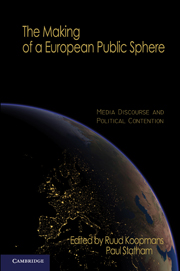Book contents
- Frontmatter
- Contents
- Tables
- Figures
- Contributors
- Acknowledgments
- Introduction
- Part I A European Public Sphere
- Part II European Public Debates
- Part III Mass Media
- 5 Making Europe News
- 6 The Media's Voice over Europe
- 7 Transnational Political Communication on the Internet
- 8 Framing the European Union in National Public Spheres
- Part IV Political Actors
- Part V Conclusion
- References
- Index
6 - The Media's Voice over Europe
Issue Salience, Openness, and Conflict Lines in Editorials
Published online by Cambridge University Press: 05 June 2012
- Frontmatter
- Contents
- Tables
- Figures
- Contributors
- Acknowledgments
- Introduction
- Part I A European Public Sphere
- Part II European Public Debates
- Part III Mass Media
- 5 Making Europe News
- 6 The Media's Voice over Europe
- 7 Transnational Political Communication on the Internet
- 8 Framing the European Union in National Public Spheres
- Part IV Political Actors
- Part V Conclusion
- References
- Index
Summary
The previous chapter has highlighted the role of the media as conveyors of news about Europe. We have seen that journalists understand their advocacy over Europe to be more information driven and educational than ideological. In this chapter we seek to understand how the press contributes as political actor to the Europeanization of national public spheres. Therefore, in this part of the overall study we treat the media as distinctive claimants (Page 1996; Pfetsch and Adam 2008), who, like other collective actors – such as governments, parties, or civil society – make their own contribution to public debate. According to professional standards, the format in which the media legitimately raise their own voice is the editorial.
- Type
- Chapter
- Information
- The Making of a European Public SphereMedia Discourse and Political Contention, pp. 151 - 170Publisher: Cambridge University PressPrint publication year: 2010
- 15
- Cited by



